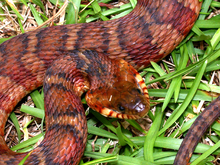Banded water snake
| Banded water snake | |
|---|---|

| |
| Scientific classification | |
| Domain: | Eukaryota |
| Kingdom: | Animalia |
| Phylum: | Chordata |
| Class: | Reptilia |
| Order: | Squamata |
| Suborder: | Serpentes |
| Family: | Colubridae |
| Genus: | Nerodia |
| Species: | N. fasciata
|
| Binomial name | |
| Nerodia fasciata (Linnaeus, 1766)
| |
| Synonyms[4] | |
| |

The banded water snake or southern water snake (Nerodia fasciata) is a
Geographic range
N. fasciata is natively found from southern
Description
Adults of the banded water snake typically range from 56 to 107 cm (22 to 42 in) in total length, with a record size (in the Florida subspecies) of 159 cm (62.5 in) in total length.[10]
It is typically gray, greenish-gray, or brown in color, with dark crossbanding. Many specimens are so dark in color that their patterning is barely discernible. The ventrum (belly) is typically an off-white to white. They have flat heads, and are fairly heavy-bodied. Banded water snakes may also be identified by a dark stripe which extends from the eye to the angle of the jaw. If irritated, they release a foul-smelling musk to deter predators.[citation needed] This species also exhibits sexual dimorphism in which the female is generally longer and heavier than the male.[11] The average frequency of skin shedding has been found to be every four weeks.[12]
Their appearance leads them to be frequently mistaken for other snakes with which they share a habitat, including the venomous cottonmouth.
Habitat
N. fasciata inhabits most freshwater environments such as lakes, marshes, ponds, and streams.[13] Banded water snakes are active both day and night and may be seen basking on logs or branches overhanging the water or foraging in shallow water.[14] They will typically stay within emergent vegetation along the shoreline or in the shallow littoral zone of their habitat. [15]
Diet
The species preys mainly on fish and frogs.
Using its vomeronasal organ, also called Jacobson's organ, the snake can detect parvalbumins in the cutaneous mucus of its prey.[5]
Reproduction
The species is
Predator avoidance
When threatened, banded water snakes flatten their bodies to appear larger and emit a foul musk from their anal glands, and bite repeatedly. They will slash sideways when biting to tear the flesh of the attacker. [22]
Subspecies
The three recognized
- N. f. confluens (Blanchard, 1923) – Broad-banded water snake [23] – Oklahoma, Arkansas, Louisiana, Mississippi, Missouri, East Texas.
- N. f. fasciata (southern Alabama, Florida, southern Georgia, South Carolina, North Carolina, southeast Missouri and Illinois.
- N. f. pictiventris (Cope, 1895) – Florida water snake, Florida banded water snake – Florida, southeast Georgia. Introduced to Brownsville, Texas and California.
Taxonomy
Some older sources have considered Nerodia fasciata to be a subspecies of
References
- ^ . Retrieved 19 November 2021.
- ^ Boulenger, G.A. 1893. Catalogue of the Snakes in the British Museum (Natural History). Volume I., Containing the Families...Colubridæ Aglyphæ, part. Trustees of the British Museum (Natural History). (Taylor and Francis, Printers). London. xiii + 448 pp. + Plates I.- XXVIII. (Tropidonotus fasciatus, pp. 242–244.)
- ^ Stejneger, L., and T. Barbour. 1917. A Check List of North American Amphibians and Reptiles. Harvard University Press. Cambridge, Massachusetts. 125 pp. (Natrix sipedon fasciata, p. 96.)
- ^ "Nerodia fasciata". Global Biodiversity Information Facility. Retrieved 16 February 2022.
- ^ PMID 22761824.
- ^ a b c d Nerodia fasciata at the Reptarium.cz Reptile Database. Accessed 26 April 2024.
- ^ "Battling an invasion of watersnakes – US Fish & Wildlife Service – Pacific Southwest Region". Fws.gov. Archived from the original on 26 December 2021. Retrieved 7 March 2022.
- ^ "California Nerodia Watch". iNaturalist.org. Retrieved 7 March 2022.
- ^ "Florida Watersnake - Nerodia fasciata pictiventris". Californiaherps.com. Retrieved 7 March 2022.
- ^ "Southern Watersnake Nerodia fasciata". Florida snake ID guide. Florida Museum of Natural History. Retrieved 26 April 2024.
- JSTOR 1444113.
- ISSN 0018-0831.
- ISBN 0-395-19977-8(paperback). (Natrix fasciata fasciata, p. 146 + Plate 20 + Map 100.)
- ^ a b "Species Profile: Banded Watersnake (Nerodia fasciata) | SREL Herpetology". srelherp.uga.edu. Retrieved 6 April 2022.
- ^ Camper, & Chick, L. D. (2010). Seasonal Variation in the Spatial Ecology of the Banded Watersnake (Nerodia fasciata fasciata). Herpetologica, 66(4), 464–475. https://doi.org/10.1655/09-029.1
- ^ Conant, R., and W. Bridges. 1939. What Snake Is That? A Field Guide to the Snakes of the United States East of the Rocky Mountains. D. Appleton-Century. New York and London. Frontispiece map + viii + 163 pp. + Plates A-C, 1–32. (Natrix sipedon fasciata, p. 103 + Plate 18, Figure 53.)
- ^ "Nerodia fasciata (Southern Water Snake)".
- S2CID 13080210.
- .
- ^ a b Wright, A.H., and A.A. Wright. 1957. Handbook of Snakes of the United States and Canada. Comstock. Ithaca and London. 1,105 pp. (in 2 volumes) (Natrix sipedon fasciata, pp. 525–529, Figure 156.)
- .
- ^ “Snakes.” Amphibians and Reptiles of North Carolina, https://herpsofnc.org/banded-watersnake/.
- ^ Powell, R., Conant, R., Collins, J. T., Conant, I. H., Johnson, T. R., Hooper, E. D., Taggart, T. W., Conant, R., & Collins, J. T. (2016). Peterson Field Guide to Reptiles and amphibians of Eastern and central North America. Houghton Mifflin Harcourt.
- ^ Schmidt, K.P., and D.D. Davis. 1941. Field Book of Snakes of the United States and Canada. G.P. Putnam's Sons. New York. 365 pp. (Natrix sipedon fasciata, pp. 221–222, Figure 72. + Plate 24, Center, on p. 344.)
Other sources
External links
Further reading
- Linnaeus, C. 1766. Systema naturæ per regna tria naturæ, secundum classes, ordines, genera, species, cum characteribus, differentiis, synonymis, locis. Tomus I. Editio Duodecima, Reformata. L. Salvius. Stockholm. 532 pp. (Coluber fasciatus, p. 378.)

